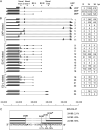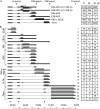The Human Adenovirus Type 2 Transcriptome: An Amazing Complexity of Alternatively Spliced mRNAs
- PMID: 33239457
- PMCID: PMC7851563
- DOI: 10.1128/JVI.01869-20
The Human Adenovirus Type 2 Transcriptome: An Amazing Complexity of Alternatively Spliced mRNAs
Abstract
We have used the Nanopore long-read sequencing platform to demonstrate how amazingly complex the human adenovirus type 2 (Ad2) transcriptome is with a flexible splicing machinery producing a range of novel mRNAs both from the early and late transcription units. In total we report more than 900 alternatively spliced mRNAs produced from the Ad2 transcriptome whereof more than 850 are novel mRNAs. A surprising finding was that more than 50% of all E1A transcripts extended upstream of the previously defined transcriptional start site. The novel start sites mapped close to the inverted terminal repeat (ITR) and within the E1A enhancer region. We speculate that novel promoters or enhancer driven transcription, so-called eRNA transcription, is responsible for producing these novel mRNAs. Their existence was verified by a peptide in the Ad2 proteome that was unique for the E1A ITR mRNA. Although we show a high complexity of alternative splicing from most early and late regions, the E3 region was by far the most complex when expressed at late times of infection. More than 400 alternatively spliced mRNAs were observed in this region alone. These mRNAs included extended L4 mRNAs containing E3 and L5 sequences and readthrough mRNAs combining E3 and L5 sequences. Our findings demonstrate that the virus has a remarkable capacity to produce novel exon combinations, which will offer the virus an evolutionary advantage to change the gene expression repertoire and protein production in an evolving environment.IMPORTANCE Work in the adenovirus system led to the groundbreaking discovery of RNA splicing and alternative RNA splicing in 1977. These mechanisms are essential in mammalian evolution by increasing the coding capacity of a genome. Here, we have used a long-read sequencing technology to characterize the complexity of human adenovirus pre-mRNA splicing in detail. It is mindboggling that the viral genome, which only houses around 36,000 bp, not being much larger than a single cellular gene, generates more than 900 alternatively spliced mRNAs. Recently, adenoviruses have been used as the backbone in several promising SARS-CoV-2 vaccines. Further improvement of adenovirus-based vaccines demands that the virus can be tamed into an innocent carrier of foreign genes. This requires a full understanding of the components that govern adenovirus replication and gene expression.
Copyright © 2020 Westergren Jakobsson et al.
Figures














Similar articles
-
Differential Splicing of Human Adenovirus 5 E1A RNA Expressed in cis versus in trans.J Virol. 2021 Feb 24;95(6):e02081-20. doi: 10.1128/JVI.02081-20. Print 2021 Feb 24. J Virol. 2021. PMID: 33361423 Free PMC article.
-
Remodelling of the host cell RNA splicing machinery during an adenovirus infection.Curr Top Microbiol Immunol. 2003;272:253-86. doi: 10.1007/978-3-662-05597-7_9. Curr Top Microbiol Immunol. 2003. PMID: 12747553 Review.
-
Promoter activity of left inverted terminal repeat and downstream sequences of porcine adenovirus type 3.Virus Res. 2005 Apr;109(1):51-8. doi: 10.1016/j.virusres.2004.10.006. Epub 2004 Nov 26. Virus Res. 2005. PMID: 15826912
-
Far upstream initiation sites for adenovirus early region 1A transcription are utilized after the onset of viral DNA replication.J Virol. 1983 Feb;45(2):594-9. doi: 10.1128/JVI.45.2.594-599.1983. J Virol. 1983. PMID: 6834469 Free PMC article.
-
Temporal regulation of adenovirus major late alternative RNA splicing.Front Biosci. 2008 May 1;13:5006-15. doi: 10.2741/3059. Front Biosci. 2008. PMID: 18508565 Review.
Cited by
-
What is the risk of a deadly adenovirus pandemic?PLoS Pathog. 2021 Sep 2;17(9):e1009814. doi: 10.1371/journal.ppat.1009814. eCollection 2021 Sep. PLoS Pathog. 2021. PMID: 34473804 Free PMC article.
-
Nanopore sequencing technology and its application in plant virus diagnostics.Front Microbiol. 2022 Jul 25;13:939666. doi: 10.3389/fmicb.2022.939666. eCollection 2022. Front Microbiol. 2022. PMID: 35958160 Free PMC article. Review.
-
From Recoding to Peptides for MHC Class I Immune Display: Enriching Viral Expression, Virus Vulnerability and Virus Evasion.Viruses. 2021 Jun 27;13(7):1251. doi: 10.3390/v13071251. Viruses. 2021. PMID: 34199077 Free PMC article. Review.
-
Direct RNA sequencing of respiratory syncytial virus infected human cells generates a detailed overview of RSV polycistronic mRNA and transcript abundance.PLoS One. 2022 Nov 10;17(11):e0276697. doi: 10.1371/journal.pone.0276697. eCollection 2022. PLoS One. 2022. PMID: 36355791 Free PMC article.
-
Characterizing the splice map of Turkey Hemorrhagic Enteritis Virus.Virol J. 2024 Aug 6;21(1):175. doi: 10.1186/s12985-024-02449-0. Virol J. 2024. PMID: 39107824 Free PMC article.
References
-
- Akusjärvi G, Pettersson U, Roberts RJ. 1986. Structure and function of the adenovirus-2 genome, p 53–95. In Doerfler W (ed), Adenovirus DNA: the viral genome and its expression. Martin Nijhoff Publishing, Boston, MA.
LinkOut - more resources
Full Text Sources
Other Literature Sources
Miscellaneous

